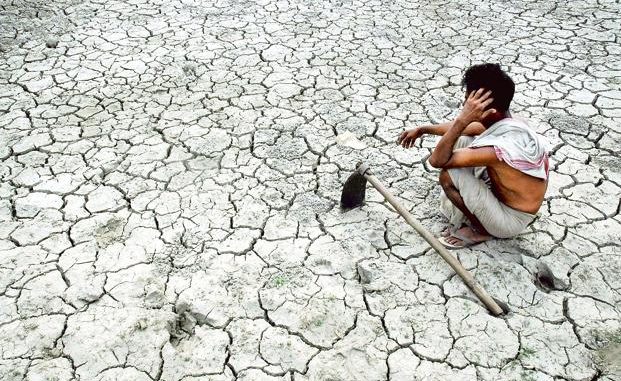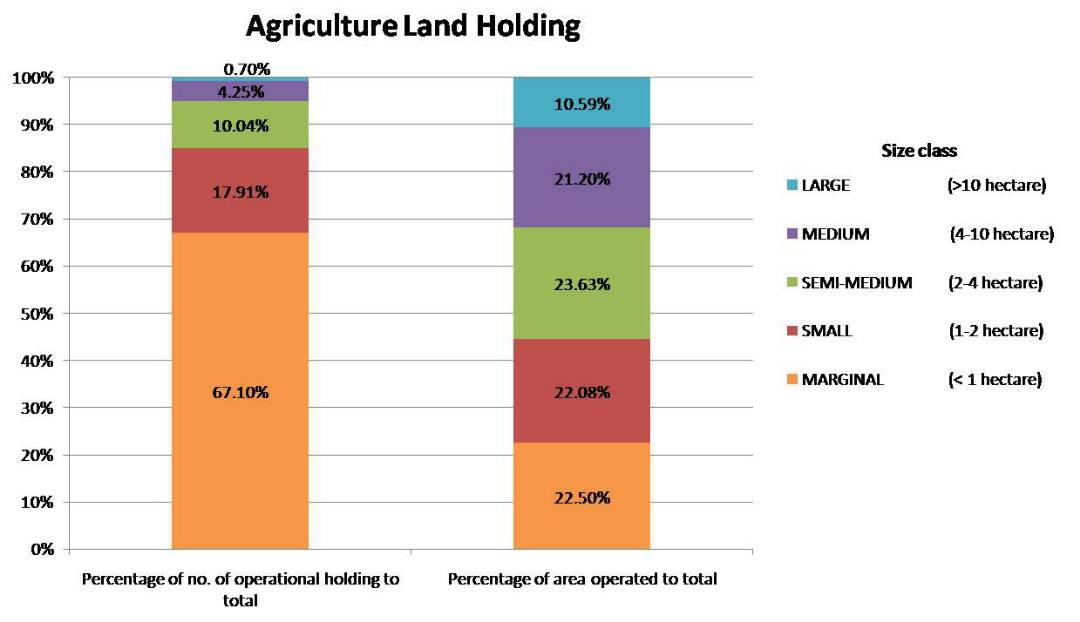There is a widespread perception that the “agrarian crisis” is more or less an outcome of natural calamities like drought which no one can fight. Governments have used this misperception in their favour to hide their inefficiencies in problem-solving. In fact, until the late 80s, governments continued to deny that a crisis even existed in the agricultural sector. The rural economy is a complex web connecting different professions which are directly or indirectly dependent on farming. Agriculture contributes about 14% to the overall GDP but its impact is felt in the manufacturing and the services sector as the rural population is now a significant consumer. This is because all people related to these fields have farmers as their main “market” or “target group” since times immemorial. It is their interdependence on each other which has been the beauty of how the Indian rural economy survived and thrived for centuries. When the agricultural output is low, the farmer’s purchasing power goes down and so does the market of non-farming entities in rural markets. These local businesses can’t venture into urban markets to sell their products as they are not in a position to compete in a highly industrial and commercialized sector, where mass production and cheap rates rule the market.
What is Agrarian crisis?
Agrarian crisis is the drive towards corporate farming, predatory commercialisation of the countryside, and it achieves the biggest displacement in Indian history, Migration or suicide are the only options with him to choose from if migration is not an option, there is hardly a choice left. The agrarian crisis doesn’t begin and end with farmer suicides. Agrarian crisis in India is like a ticking time-bomb, and it’s crucial to rectify the mistakes which are contributing to it.
Farmer Suicides
Joseph Stalin once famously remarked “one death is a tragedy, one million is a statistic” and merely a statistic is what has become of our farmers. National crime records bureau has estimated that nearly 330000 farmers have committed suicides since 1995. i.e. 11.2% of the total suicides committed. These are concentrated 90% happen in Maharashtra, Andhra Pradesh, Madhya Pradesh, Karnataka and Kerala. It is the suicide of about 50% of Indians working in agriculture.
Some Reasons for Suicide
Habits like drinking, gambling, Failure of crop, other family problems, Chronic illness, Marriage, Debt burden, Droughts, etc.
Irrigation
India is monsoon dependent for farming, if monsoons are good, the entire economy is positive and when the monsoon fails, everyone everywhere takes a plunge to some extent. The problem is of poor management of water. The motto of “more crop per drop” under the Prime Minister Agriculture Irrigation Scheme is a step towards this, although it needs to be implemented on the ground before it can be properly lauded.
Seed Problems
Most farmers depend on the market for seeds. The HYV and GM seeds which promise higher yields force the farmers to buy seeds for every crop. With spurious seeds hitting the market, the farmers’ woes have increased. The yields are not as stated and this leads to economic troubles. They require high amounts of fertilisers, pesticides and water. These problems can be overcome by creating in house seed banks at the village level for traditional crops, selling Government approved seeds through proper channels and proper regulation to protect farmers from dubious seed companies and penalise such companies in case the seeds do not match the claims on germination and yield. Terminator seeds should not be encouraged as a matter of principle as they force farmers to buy seeds for every crop.
There are other problems in Indian agriculture system like sustainability issues, over dependence on traditional crops like rice and wheat, supply channel bottlenecks and lack of market understanding, Storage and governments mismanaged warehouses.
Price of Produce
There is a deeper shift in agriculture towards cash crops and it makes them vulnerable to change in prices. Market interests are important but not at the expense of farmers. Also, the former can’t survive if the latter doesn’t. Farmers are the real providers of food security to everyone. Steps should be taken to remove the middlemen between the farmers and consumers. This would ensure price stability of the essential commodities and the burden of increasing price would be eased on both the farmers and consumers.
Land Holding
Less than 5% land holdings account for close to 1/3rd of total area, while the number of Medium & Large holdings account for less than 5%, they make up for close to 1/3rd of the total area under operation. Though the number of Marginal & Small holdings account for 85% of the total number of holdings, they together account for only 45% of the total area under operation. 67% farmers have land less than 1 hectare. Large land holdings enable the farmer to implement modern agricultural techniques and boost productivity. Small land holdings restrict the farmer to use traditional methods of farming and limit productivity as more people invariably work on the farms in the rural areas and coupled with the obsolete technology, farm incomes come down. Lands should be consolidated and cooperative farming should be practiced. This consolidated land can be farmed by using the latest technology.
Debt Burden And Awareness
The average debt of an Indian farmer is Rs.47000 and their monthly income is meagre Rs. 6426.This makes it difficult for farmers to have financial stability. Steps must be taken in order to protect farmers from private moneylenders who follow highly exploitative practices. Awareness need to be created among rural populations about new schemes and their rights. Such an effort needs to be made keeping in mind the low rates of literacy in rural areas, particularly for women—their level of awareness on technical and non-technical aspects of modern agriculture is understandably low. Though the government has launched a TV channel called DD Kisan for the benefit of farmers, there is no quality research on whether the target audience is watching it or not. Lack of resources and the absence of adequate incentive structures have led to break-down of extension services in most states. There are many lacunae in the loan waiver schemes and other schemes in this regard by the government.
Interest Rates
The crop loans up to Rs. 3 lakhs are available at the interest rate of 7% p.a. Govt. of India also provides interest subvention of 3% p.a. to prompt repaying farmers. To bring more farmers within the institutional credit fold, Government has extended this scheme to crop loans borrowed by farmers from Private Sector scheduled commercial banks in respect of loans given within the service area of the branch concerned. As per RBI instructions, no separate security is required for crop loans up to Rs. 1 Lakh.
Subsidies
The subsidies given in our country are less and most of it is lost midway or looked at as unproductive further subsidies are going to the big and medium farmers – A survey commissioned by NABARD and undertaken by Punjab Agriculture University has confirmed that 94% of the government subsidies are being availed by big and medium farmers. The fastest thing growing in our country is not IT or Software it is inequality. The rich are given more than the poor but in the name of incentives. Industrial greed before the farmers’ needs worsens the problem. The steps taken like linkage of subsidies through Aadhar card and other steps give a glimpse of hope.
The WTO is also to blame for this; it tells the farmers of the poor countries like Chad, Mali, Bennon, Burkina Faso to become market friendly and viable. If that was the case USA and EU countries can never be viable their crop produce value less than subsidies given.
Who Is a Farmer And Insurance Policies?
Government says, “only one on whose name the land is registered are seen as farmers”. The rest escape consideration. This is problematic because most people toiling in the fields are landless labourers who work for a pittance. The landed farmers are generally big farmers with large land holdings. What happens under the current system is that whenever crop failure happens due to natural calamities such as drought, floods etc, it’s the landowners who get the compensation and not the land tiller. This is sheer injustice due to the lacunae in the system. Further the farmer gets his reimbursement for a long period of time which takes away its benefits. The other aspect is that all these are new institutional innovations and it takes time for people to understand the mechanism. Farmers complain that they pay every year but don’t get their money back every year.
I would like to leave you with a Vision of India
Where the farmer is without fear
Where the farmer is without fear and his silos stand high
Where the extension department imparts him right knowledge
Where the agri-inputs suppliers are no longer fooling him
With spurious fertilizers and dubious salts
Where the yields are returned by the sweat of his brow
Where he has a decent income to live a reasonable life
Where the unseasonal rains do not destroy his crop
Where the green lush fields of yesteryear reappear
Where the farmer is indeed supported by his country
Where suicides become a thing of the past
Into ever-widening progress, happiness and results
Into that true Green Revolution, they long for,
My father let our farmers awake.
By Yash Rabadia
Poetry – Shivendra Singh
Image source: Development news.
The Economic Transcript- June 2017 Issue.





